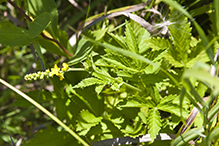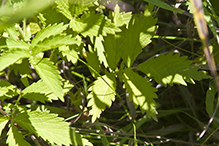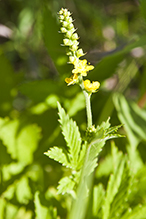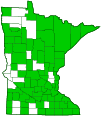Roadside agrimony
(Agrimonia striata)
Conservation • Wetland • Description • Habitat • Ecology • Use • Distribution • Taxonomy
Conservation Status |
|||
| IUCN Red List | not listed |
||
| NatureServe | NNR - Unranked SNR - Unranked |
||
| Minnesota | not listed |
||
Wetland Indicator Status |
|||
| Great Plains | FACU - Facultative upland |
||
| Midwest | FACU - Facultative upland |
||
| Northcentral & Northeast | FACU - Facultative upland |
||
Description
Roadside agrimony is an erect, up to 40″ tall, perennial forb that rises from fibrous roots.
The stems are stout and round in cross-section. They are covered below the middle with coarse, stiff hairs, above the middle with both hairs and glands.
The leaves are alternate and pinnately divided into up to an odd number of leaflets. The largest leaves have 7, 9, or 11 primary leaflets. Between each pair of primary leaflets there is another, much smaller pair of secondary leaflets. At the base of each compound leaf is a pair of leaf-like appendages (stipules). The stipules are ⅜″ to ¾″ long, lance-shaped to almost egg-shaped, and coarsely toothed or narrowly lobed. The stipules of the middle stem leaves have an elongated, lance-shaped lobe or tooth at the tip.
The leaflets are lance egg-shaped, 1½ to 2 times as long as wide, and conspicuously veined. The upper surface is hairless or nearly hairless. The lower surface is smooth or rough to the touch; sparsely covered with more or less appressed hairs, especially along the veins; and conspicuously dotted with glands. The margins are coarsely toothed.
The inflorescence is a short-stalked, spike-like, densely crowded, unbranched cluster (raceme) of many flowers at the end of the stem and upper branches. The central axis of the raceme (rachis) is densely covered with fine, short, ascending hairs. There are no glands on the rachis. The inflorescence elongates in fruit.
The flowers are about ¼″ in diameter. There are 5 overlapping green sepals, 5 yellow petals, and 5 to 15 stamens. The hypanthium is top-shaped and conspicuously grooved. There is a line of white, appressed hairs in the grooves and two or more rows of hooked bristles on the outer rim. The bristles are strongly ascending or erect.
The fruit is 1 or 2 achenes concealed within the hypanthium.
Height
Up to 40″
Flower Color
Yellow
Similar Species
The relatively short, densely packed raceme distinguishes this from all other Agrimonia species.
Common agrimony (Agrimonia gryposepala) largest leaves have 5, 7, or 9 primary leaflets. The rachis is conspicuously covered with gland-tipped hairs as well as scattered, long, spreading hairs. The grooves on the hypanthium do not have a line of white hairs. The outer bristles on the rim of the hypanthium are widely spreading or bent backward.
Soft agrimony (Agrimonia pubescens) largest leaves have 5 to 13 primary leaflets. The leaf undersides are velvety to the touch with strongly spreading hairs. Glands on the underside of the leaf are absent or are inconspicuous and hidden by the longer, velvety hairs. The stipules of the middle stem leaves are egg-shaped to kidney-shaped and do not have an elongated tooth or lobe at the tip.
Habitat
Dry to moist. Woods.
Ecology
Flowering
July to August
Pests and Diseases
Use
Distribution |
||
|
Sources Biodiversity occurrence data published by: Minnesota Biodiversity Atlas (accessed through the Minnesota Biodiversity Atlas Portal, bellatlas.umn.edu, 10/23/2025. |
|
| 10/23/2025 | ||
Nativity |
||
Native |
||
Occurrence |
||
Common |
||
Taxonomy
Kingdom
Division
Tracheophyta (Vascular Plants)
Subdivision
Spermatophytina (Seed Plants)
Class
Order
Rosales (Roses, Elms, Figs, and Allies)
Family
Rosaceae (Rose)
Subfamily
Rosoideae (Brambles, Roses, Strawberries, and Allies)
Tribe
Agrimonieae (agrimonies and burnets)
Subtribe
Agrimoniinae (agrimony)
Genus
Agrimonia (agrimonies)
Tribe
NCBI places the subtribe Agrimoniinae in the tribe Sanguisorbeae. However, according to Flora of North America, the tribal name Agrimonieae has priority over the name Sanguisorbeae.
Subordinate Taxa
Synonyms
Agrimonia brittoniana
Agrimonia striata var. campanulata
Eupatorium brittonianum
Common Names
grooved agrimony
roadside agrimony
woodland agrimony
woodland groovebur
Glossary
Achene
A dry, one-chambered, single-seeded seed capsule, formed from a single carpel, with the seed attached to the membranous outer layer (wall) only by the seed stalk; the wall, formed entirely from the wall of the superior ovary, does not split open at maturity, but relies on decay or predation to release the contents.
Hypanthium
A cup-like tubular structure of a flower formed from the fused bases of sepals, petals, and stamens, that surrounds the pistil. Its presence is diagnostic of many families, including Rosaceae, Ribes, and Fabaceae.
Pinnate
On a compound leaf, having the leaflets arranged on opposite sides of a common stalk. On a bryophyte, having branches evenly arranged on opposite sides of a stem.
Raceme
An unbranched, elongated inflorescence with stalked flowers. The flowers mature from the bottom up.
Rachis
The main axis of a compound leaf, appearing as an extension of the leaf stalk; the main axis of an inflorescence.
Visitor Photos
Share your photo of this plant.
This button not working for you?
Simply email us at info@MinnesotaSeasons.com.
Attach one or more photos and, if you like, a caption.
Dan W. Andree |
||
Plant with small yellow blossoms... |
||
 |
 |
|
Blooming plant |
Plant with small yellow flower clusters |
|
MinnesotaSeasons.com Photos
 |
 |
|
 |
||
|

Slideshows

Visitor Videos
Share your video of this plant.
This button not working for you?
Simply email us at info@MinnesotaSeasons.com.
Attach a video, a YouTube link, or a cloud storage link.
Other Videos

Visitor Sightings
Report a sighting of this Plant.
This button not working for you?
Simply email us at info@MinnesotaSeasons.com.
Be sure to include a location.
MinnesotaSeasons.com Sightings


